Content
From MIPEX to DPMAdirekt
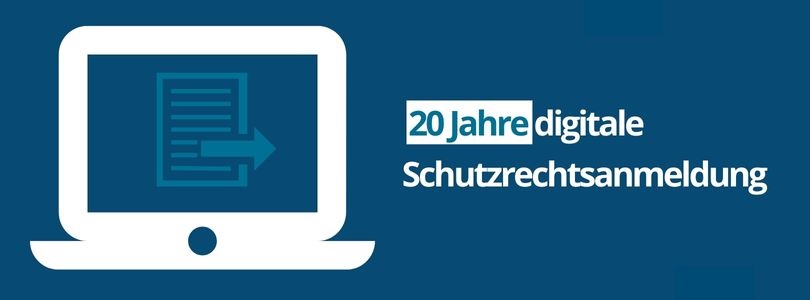
20 years of digital IP filing and 2 million documents received
From “MIPEX project” to “PaTrAS” – European patent offices jointly developed secure online application procedures
In the late 1990s, forms embedded in web pages, file transfer protocols that were not transparent for laypersons and first (open) messenger services and e-mail services were usual on the internet. Secure transaction systems, though, were just being discussed and tested. However, at that time too, legally secure online transactions were subject to strict requirements such as encryption, secure means of transmission, authentication and digital signature.
With no commercial, ready-to-use software being available for these tasks, several European patent offices started the MIPEX project (which stands for Message based Industrial Property information EXchange) in 1996. In addition to the creation of a secure network of these patent offices, the development of secure online application procedures was one of the key tasks from 2000 onwards.
Ultimately the patent offices of Germany, the United Kingdom, Sweden, Denmark and Switzerland jointly commissioned a software package (“PaTrAS – Patent and Trademark Application System”) that was intended to be applicable at the international level. To facilitate matters, the means of transmission chosen at that time was the e-mail with an encrypted and signed attachment. By contrast, the data structure requirements were particularly demanding: Only structured data were allowed, so it was possible to handle all data received by the offices without additional extensive processing or conversion by hand. For example, the transmission of the filing data and all full texts was implemented in WIPO standard-compliant XML format. Based on the requirement to structure the full texts in the same way, the dimensions of the MIPEX project went far beyond those of parallel projects of the Japan Patent Office and the European Patent Office.
4 July 2002: The DPMA received the first electronic application
In 2001 PaTrAS was ready for use and in test operation. Large applicants and providers of IP management systems received training on how to integrate PaTrAS into their own workflows. On 4 July 2002 the DPMA received the first electronic application, from Siemens AG (patent specification: DE 102 30 170 B3). This application was also filed as a paper application. In August 2003, upon entry into force of the “Ordinance on Electronic Legal IP Transactions” (Verordnung über den elektronischen Rechtsverkehr im gewerblichen Rechtsschutz), the e-filing system could go live.
PaTrAS in the BundOnline2005 project at the CeBIT trade fairs 2003 and 2004
PaTrAS was not a quick success: The high standards for the data to be submitted and the complex procurement of signature cards were initially an obstacle for applicants. The system as such was unique at the time: It could be used to process a complete, signed document package including the application form, full texts and images. Accordingly, PaTrAS was also considered in other projects: E-filing at the DPMA became part of the BundOnline2005 project and was presented at the CeBIT trade fairs 2003 and 2004, for instance.
The DPMA adopted the server software of the electronic receiving service from the BundOnline2005 project; this software completed the online submission system. There was also cooperation with the European Patent Office: The two offices agreed that German and European applications in the WIPO data standard could mutually be filed with the EPO and the DPMA. This agreement made it easier for applicants to use the system: First, they had to install only one software package, either PaTrAS or the EPO’s software. Second, it was easier to get signature cards that way, as the EPO already issued its own signature cards.
By using XML technologies and data standards of WIPO, a future-proof and easily extensible system was created, facilitating the integration into other systems and the construction of interfaces. The DPMA had thus assumed a pioneering role in e-government.
DPMAdirekt - a one-stop program
The original idea that IP management systems used by customers create, and use PaTrAS to validate and transmit, the required data was not taken up as expected at that time. For this reason, the DPMA developed the DPMAdirekt application, which customers could use to take all necessary steps for an application with a single program. For this purpose, the existing components of PaTrAS were integrated into the new application DPMAdirekt. To further facilitate the filing of electronic patent applications, it was possible to submit the text parts (summary, description and claims) as PDF files from 2007 onwards.
In the following years, the other offices of the MIPEX project turned their attention to individual, national solutions, so the software of the DPMA became a purely national solution. From 2012 onwards the results of the MIPEX project were only used in Germany, and the DPMA intensified its cooperation with the international offices, WIPO and the EPO.
DPMAdirektWeb: Since 2013 trade mark and design applications have also been possible via a web-based service
As regards trade marks and designs, the share of electronic filings was smaller than expected. Analyses showed that many applicants of these IP rights file relatively few applications. Applicants probably did not consider it worthwhile to have to procure a signature card and additionally install specific software. Since November 2013 DPMAdirektWeb has therefore offered an easy and uncomplicated option to file both trade mark and design applications via the user interface of a web browser. As a result, the majority of trade marks and designs are now filed with the DPMA by using this low-threshold e-filing service.
We have since extended electronic access beyond the mere application. For example, since as early as 2013, it has been possible for the first time to subsequently file patent documents; today, this is possible with respect to all types of IP rights and most types of documents.
In addition, the original idea of an integration into customers’ IP management systems by providing a comprehensive interface in DPMAdirektPro has been pursued and is now implemented in all major systems on the market.
All correspondence can now be exchanged seamlessly
For a long time, communication via the DPMAdirektPro and DPMAdirektWeb services was of quite a one-way nature. Customers were able to file applications and submit documents, and received a confirmation of receipt as reply – in the case of an application, including the file number. Only since the introduction of a new version of DPMAdirektPro in 2017 has the DPMA too been able to send electronic letters and communications to users. After registration for electronic letters and communications, customers are able to receive data in DPMAdirektPro and to automatically export them into their own systems and thus to seamlessly exchange all correspondence.
The benefits of DPMAdirektPro both sides enjoy are obvious: Pay lower fees to apply for IP rights and immediately receive a confirmation of receipt. Customers receive step-by-step guidance to navigate through the application and the subsequent filing of additional documents in the procedure, and the data are subjected to extensive plausibility checks. In this way, inconsistencies can be remedied immediately. At the DPMA, this pre-processing of the digital data results in fewer mistakes and thus complaints. At the same time, the examining sections benefit from improved data quality. Additional valuable functions of the application are imports of directories, lists of goods and services and the creation of recurring templates of IP applications or subsequent filings.
Trade Mark Law Modernisation Act and amended Ordinance on Electronic Legal Transactions with the DPMA – DPMAdirektWeb offers new functions
Within the scope of the Trade Mark Law Modernisation Act (Markenrechtsmodernisierungsgesetz) and the amended Ordinance on Electronic Legal Transactions with the DPMA (Verordnung über den elektronischen Rechtsverkehr beim Deutschen Patent- und Markenamt), we have added many functions to DPMAdirektWeb, e.g. the application of new forms of trade marks. It is possible to interrupt the completion of the web application at any time: The work progress can be exported and the processing can be restarted at a later time. Requests for international registration of German trade marks that the DPMA forwards to WIPO can also be filed via DPMAdirektWeb. These technical adjustments were possible only because of the concurrent conversion to a new technology. Subsequently, we were able to incorporate the experience gained into the adaptation of DPMAdirektWeb for design applications and the specification of the purpose of use of the SEPA mandate.
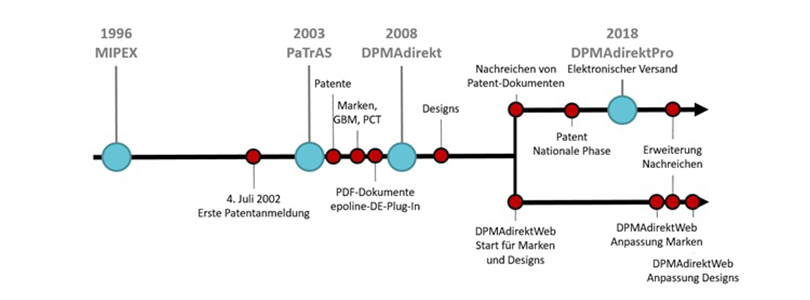
Meilensteine der digitalen Schutzrechtsanmeldung beim DPMA
In constant dialogue with our customers
We offer our customers regular workshops and dialogue events. Furthermore, we receive regular information through the technical application support staff, the Central Customer Care and Services of the DPMA and from the IP right areas. We forward this feedback to the product development team to achieve the best result for all parties involved. For example, in 2020, we designed the user interfaces of both applications in such a way that, thanks to a change of the navigation for each type of IP right, almost every document content can be selected. An optimised categorisation of the document types allows quick further processing.
The DPMA is highly committed to protecting personal data and offering secure IT applications. This means that we always try to find a viable compromise between the framework conditions of data protection, IT security and user-friendly communication channels. We thus provide secure user authentication and quick and uncomplicated digital communication with the DPMA. The first million documents submitted to the DPMA were reached 17 years after the project had been launched, the second million were reached only two and a half years later. It is difficult to forecast when the next million documents will be reached. But one thing is certain: We will continue to develop the service and make it more customer-friendly for you.
Last updated: 20 May 2025

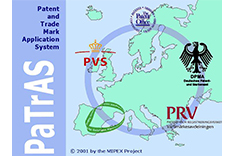
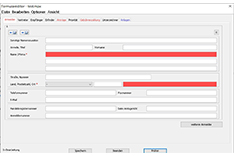
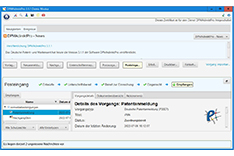
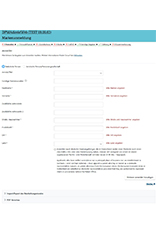
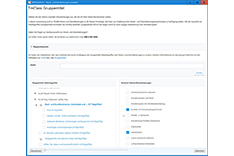
Not only protecting innovations
Social Media